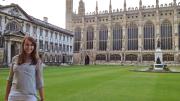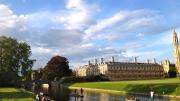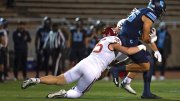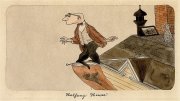The Cambridge across the pond is somehow familiar to me, though it’s my first time here. Early each morning the first tour buses arrive. The passengers stumble out bleary-eyed, clutching their cameras. Accents and languages mingle in the streets. Later the students will join them, tugging the city awake.
I suppose that I thought I’d come to this other Cambridge, to take classes for eight weeks, and that it would be preserved perfectly just for me—like one of those restored, “working” New England towns where you can take pictures of colonial women churning butter. It would be peculiarly British and quaint.
But I was first struck by the similarities, rather than the contrasts, between this Cambridge and my own. Both are university cities, the borders between town and gown blending freely. Both are tourist attractions in their own right. Both even have their own rallying photo-op point for tour groups: here, instead of John Harvard, it’s Stephen King’s Corpus Clock—a steel locust perched atop the contraption flashes its LED-lit eyes in the dark. I recently learned that it was meant as a sort of modern memento mori. The locust moves mechanically over the clock each second, consuming each second, as a reminder of how few we have left. Now it strikes me as a bit odd to see cheery tourists clustered around it, oblivious to the clock's more sinister implications.
Most of the students studying alongside me are not British but American—like me, no more than temporary visitors. Cambridge students have gone home or abroad or to London, strewn throughout the world for the summer just like their Massachusetts counterparts. A few hardy souls remain to guide us clueless foreigners—in return they receive free lodging and a chance to work on their own theses or projects—but the regular Cambridge has been emptied out for the summer. It retains only its magnificent architectural shell, which we tourists and summer students are only too happy to fill up.
I can try to distinguish myself from the mass of tourists: I can flash my Pembroke-Kings Student Programme ID and glide past the guards at the entrance to King’s College, skipping the £4 entry fee. I can study in Pembroke College Library and eat lunch at the Cambridge Union Society. I can borrow the university’s boats to go punting along the College Backs. But as I duck through the gate and wave hello to the porters, snapping a surreptitious picture of the King’s College grounds, I often feel like I’m intruding on something not quite my own.
Although, when I think about it, how much can I really say Harvard and the other Cambridge are mine? For now, they are my life and work, my friends and professors. And the Houses and Yard provide a kind of continuity—the institution seems stronger and more eternal than the sum of its parts. But two years from now, when my last box is packed, will I feel the same tug of belonging? In 10 or 20 years, will I recognize that specific feel of the place when I return for reunions?
People visit Harvard and Cambridge and other prestigious universities not only for their reputation, but also to revel in the physical impressiveness of their settings. Here I am drawn inevitably to the pristine courtyards, where only fellows and professors are allowed to walk across the grass; and to the Annenberg-esque dining hall, where fifteenth-century college masters glare down at me disapprovingly. I find a similar sense of this security of age at Harvard. The difference here, of course, is the scope—1636 seems less impressive when I pass a pub with an “est. 1430” sign hung on the door—but also the fact that my stay here is no more than transitory.
Because a university isn’t, obviously, just the campus that makes it up. At one of the Formal Halls here at Pembroke College—weekly dinners with free-flowing wine and grace said by the Fellows—one of them quoted Cardinal John Henry Newman on the topic. Cardinal Newman, an Oxford man himself, thought that a university could be defined as “a place of concourse, whither students come from every quarter for every kind of knowledge.” The physical characteristics didn’t matter so much, he wrote in his “Idea of a University”—London and Paris were “universities” of a sort, even without the London School of Economics or the Sorbonne. Universities were, in general, to be “a place for the communication and circulation of thought, by means of personal intercourse, through a wide extent of country.”
So the idea is that anywhere people engage in intellectual activity together, an institution of learning develops. The ivory towers and spires merely serve to consecrate this activity. They shut it up within their walls: limiting it, perhaps, but also protecting it. I like this idea of a university—it makes me feel like less of an intruder here in the other Cambridge. I’m certainly not immersed in the culture here. But through classes and conversations, seminars and papers and all the banal aspects of daily college life, maybe it becomes justifiable to usurp a campus for the summer. We Harvard undergraduates tend to look down upon the Summer School students who replace us from June to August, not to mention those at the Extension School, for instance. But this summer at the other Cambridge has made me more sympathetic to their status—are they not perhaps part of the university, too?










